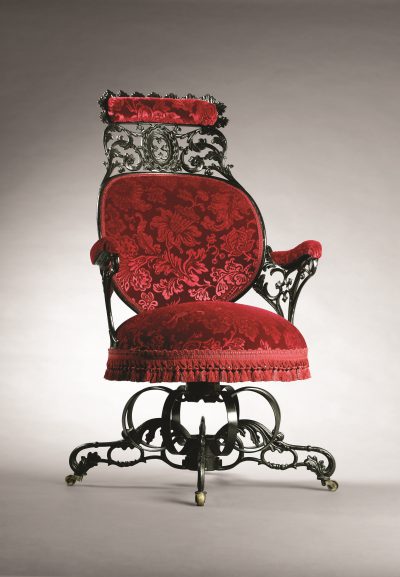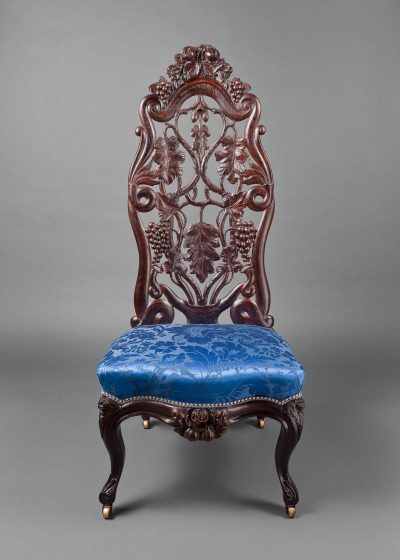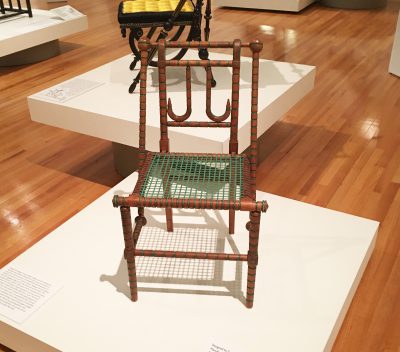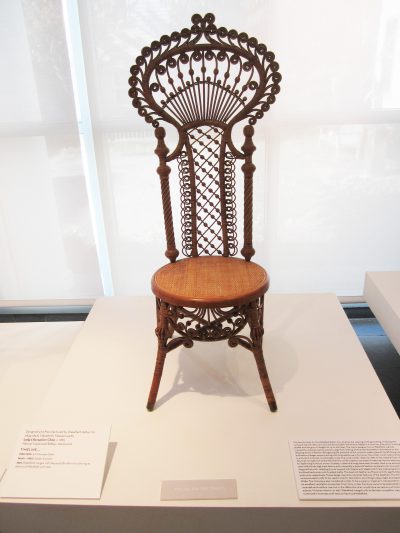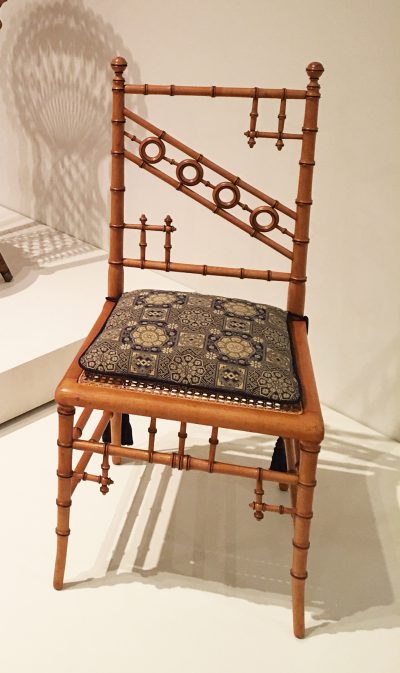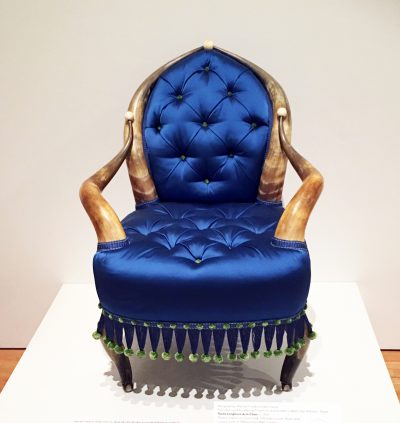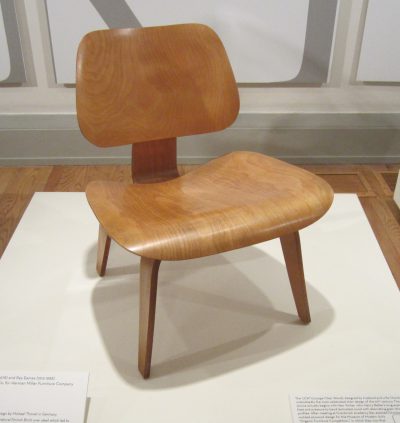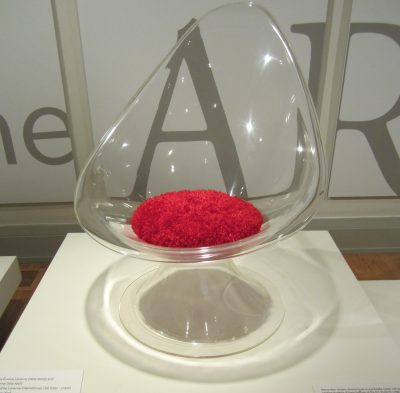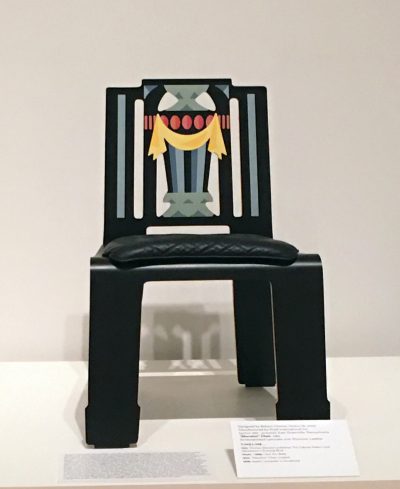The Art of Seating: Two Hundred Years of American Design
*Check our homepage or call for opening information before coming to see this exhibition.
The Art of Seating is organized by the Museum of Contemporary Art, Jacksonville, in collaboration with the Thomas H. and Diane DeMell Jacobsen Ph.D. Foundation and is toured by International Arts & Artists, Washington, D.C.
Few objects tell the history of modern design as eloquently as the chair. Aesthetics trends, the emergence of new technologies, ergonomics, and social and cultural developments are all reflected in the evolution of chair design.
Stark Galleries | Memorial Student Center, MSC 1110
Virtual Tours
Move and click your mouse inside the views below to see this exhibition.
Audio Tours
Learn more about chairs in the collection from these audio guides.
| Click to view larger |
Centripetal Spring Arm Chair
Designed by Thomas E. Warren (active with American Chair Co. 1849-52), Manufactured by the American Chair Co., Troy, New York (1829-1858), Centripetal Spring Arm Chair, c. 1850, Cast Iron, Wood, Sheet Metal, Gauffrage Velvet Cover, Faux Rosewood Graining Press play to learn more. |
| Click to view larger |
Slipper Chairs
Designed and Manufactured by John Henry Belter (1804-1863), New York, New York Slipper Chair, c. 1855, (Grape Vine and Oak Leaf) Carved and Laminated Rosewood, Casters, Silk Damask Cover
Slipper Chair, c. 1860 Carved and Laminated Rosewood, Oak, Silk Damask Cover (Original foundations)
|
| Click to view larger |
Wire Seat Side Chair
Designed by George Hunzinger (1855-1898), Manufactured by George Hunzinger, New York, New York, Wire Seat Side Chair, c. 1876, Maple, Polychrome, Cotton Covered Metal Straps |
| Click to view larger |
Lady’s Reception Chair
Designed and Manufactured by Wakefield Rattan Co.(1844-1897), Wakefield, Massachusetts, Lady’s Reception Chair, c. 1885, Natural Unpainted Rattan, Hardwood |
| Click to view larger |
Faux Bamboo Side Chair
Designed by Robert J. Horner (c. 1855-1922), Manufactured by R.J. Horner and Co. (1886 – c. 1915), New York, New York, Faux Bamboo Side Chair, c. 1880-90, Maple, Cane |
| Click to view larger |
Texas Longhorn Arm Chair
Designed by Wenzel Friedrich (1827-1902), Manufactured by Wenzel Friedrich (active 1880-c.1890), San Antonio, Texas, Texas Longhorn Arm Chair, c. 1890, Texas Longhorns, Ivory, Oak, Silk Satin Cover, Brass and Louis Comfort Tiffany Glass Ball Casters |
| Click to view larger |
LCW (Lounge Chair Wood)
Designed by Charles Eames (1907-1978) and Ray Eames (1912-1988), Manufactured by Evans Products, Co. for Herman Miller Furniture Company (Est. 1923), Grand Rapids, Michigan, LCW (Lounge Chair Wood), c. 1945, Molded Birch Plywood |
| Click to view larger |
Acrylic Chair
Designed by Erwine Laverne (1909-2003) and Estelle Laverne (1915-1997), Manufactured by Laverne International, Ltd. (1957 – c.1972) New York, New York, Acrylic Chair, 1957, Molded Acrylic Resin, Polyester Upholstery |
| Click to view larger |
“Sheraton” Chair
Designed by Robert Charles Venturi (b. 1925), Manufactured by Knoll International Inc. (active 1951 – present), East Greenville, Pennsylvania, “Sheraton” Chair, 1984, Screenprinted Laminate over Plywood, Leather |
About
The Art of Seating, organized by the Museum of Contemporary Art, Jacksonville, Florida, presents a survey of exceptional American chair design from the early 19th century to the present day. Designed for function, each chair has a story to tell about our national history and the evolution of American design, art, and craftsmanship. The chair is experienced not only as a functional item, but also as sculptural in view—the chair as art.
Each of the more than 40 chairs in the exhibition are from the Jacobsen Collection of American Art and were chosen for their beauty and historical context with important social, economic, political, and cultural influences. Highlights include designs by John Henry Belter, George Hunzinger, Herter Brothers, Stickley Brothers, Frank Lloyd Wright, Charles and Ray Eames, Eero Saarinen, Isamu Noguchi, and Frank Gehry, among others.
Not only does the exhibition provide an opportunity for the viewer to see readily recognizable pieces alongside those rarely seen by the public, it also takes the viewer into the design studio through patent drawings, documented upholstery, artist renderings, and multimedia presentations.


